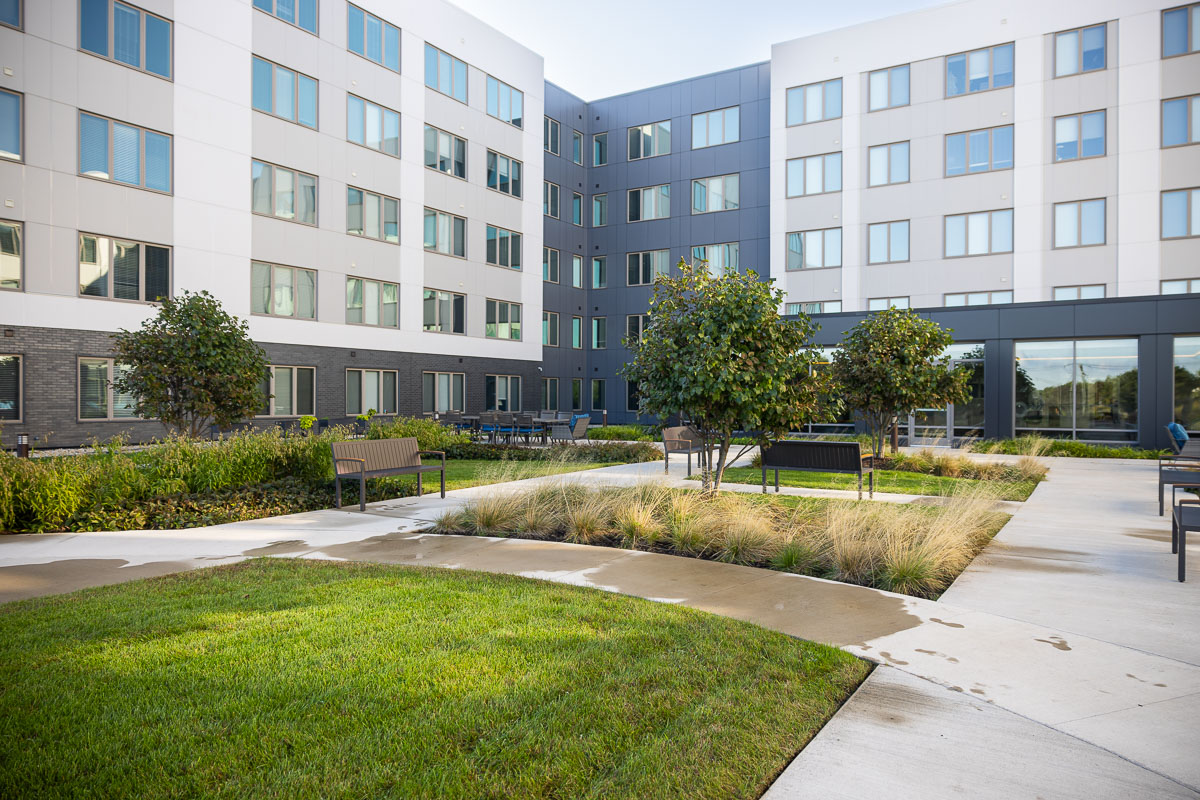
Top Native Plants for Your Chicagoland Commercial Landscape

Vibrant blooms, lush foliage, and buzzing pollinators–and beneficial to the Chicagoland environment. Sounds too good to be true, right?
Native plants can actually be your secret weapon for a beautiful landscape that contributes positively to our environment. These sustainable, cost-effective plantings are a great solution for landscaping commercial buildings.
Let’s take a closer look at why native plants are a great match for your business and share a selection of our top picks. With these recommendations, you can alleviate your landscaping concerns and refocus your attention on more important things like running your business.
What are Native Plants?
Native plants are those that naturally occur and have evolved in a particular region, ecosystem, or habitat without human intervention. These plants have adapted to the local climate, soil conditions, and other environmental factors over time, making them well-suited to thrive in their native habitats. Native plants have the following characteristics:
- Adaptability: Native plants are well-adapted to the local environment, including climate, soil type, and precipitation patterns.
- Biodiversity Support: They play a crucial role in supporting local biodiversity by providing habitat and food sources for native wildlife like birds, insects, and pollinators.
- Resilience: Native plants often have deep root systems that help prevent soil erosion and drought stress, making them more resilient to extreme weather conditions.
- Ecosystem Contributions: They contribute to various ecosystem services such as improving soil health and enhancing water quality.

Why are Native Plants Important at Your Commercial Property?
Native plants are especially well fit for commercial properties because of their adaptability. Their ability to promote biodiversity plays an important role in making your landscape more sustainable.
In addition to their adaptability, native plants are much more cost-effective than their non-native counterparts. Native landscapes are built to be resilient, so once established there will be very little plant replacement necessary. Native plants make for a functional and beautiful landscape. With frequent pollinators visiting your native garden, this type of landscape can help boost employee morale too!

Considerations When Including Native Plants for Commercial Landscaping
Before you begin to plan your native plant garden, it is important to consider several things.
- Plant Selection: Be sure to consult with a professional to ensure you are choosing the right variety of plant species. Native Chicagoland plants are different from Native Georgia plants for example.
- Scale: Native plants can be installed on a small scale with a well-designed and intentional look. They can also be utilized on a large scale that provides beauty, habitat, and water runoff control.
- Location: Just like any planting, native Chicagoland plants need their location tailored to their needs. Investigate if your plant is sun or shade-tolerant and water-loving or drought-tolerant. Knowing these specifics about your native plant can help you to select the right location on your property.
- Maintenance: The first three years are crucial for establishing a resilient planting. Ensure plants have adequate water, regular weeding, and specifically timed mowing or trimming.

6 Native Chicagoland Plants for Your Commercial Property
While there are hundreds of excellent native plants for commercial landscaping, these varieties are some of our favorites. These six native plant varieties are excellent choices for landscaping projects, thriving in full sun and boasting impressive drought tolerance. Not only do they withstand excess runoff, but they are classified as ‘aggressive natives’ meaning they naturally spread throughout your garden area. This trait translates to a greater value for your investment, as they outcompete weeds and require minimal maintenance.

In addition to their practical benefits, incorporating these varieties into your garden design promises a vibrant array of colors and bloom times. With varying heights and textures, they add visual interest to your landscape while providing essential food and habitat for local wildlife.
1. Black-eyed Susan
This bright and beautiful flower boasts yellow petals with a bold black center. These hardy flowers bloom from mid-summer to early fall, adding a burst of color to gardens and landscapes. Aside from their beloved, cheerful appearance, they are known for attracting pollinators such as bees and butterflies.
2. Common Milkweed
Common Milkweed is best known as the primary food source of the beautiful Monarch butterfly caterpillars, making it a crucial component of Monarch butterfly conservation efforts. Milkweed is characterized by its tall, upright stems. Flowers are clustered and are pink to purplish-pink in color and have a sweet, pleasant fragrance.
3. Blue Wild Indigo
This striking perennial planting is known for its vibrant blue flowers and beautiful ornamental foliage. The leaves are a bluish-green color and add texture to the landscape throughout the growing season. In late Spring to early summer, the Blue Wild Indigo produces stunning spikes of pea-like flowers above the foliage that are typically bright blue, though they can be white or yellow.
4. Pale Purple Coneflower
Coneflower, often known by its scientific name, Echinacea, is one of the most popular native plants in the Midwest. The plant features distinctive pale purple ray flowers surrounding a spiky central cone, giving it its characteristic coneflower shape. These flowers bloom from late Spring to mid-summer and are attractive to a variety of pollinators including bees, butterflies, and hummingbirds.
5. Prairie Blazing Star
Prairie Blazing Star is characterized by its tall, upright stems, which can reach heights of three to five feet. The plant produces dense, cylindrical spikes of tiny purple flowers that bloom from late summer to early fall.
6. Little Bluestem
Unlike the other five native Chicago plants, Little Bluestem is actually a perennial grass. The foliage consists of slender, blue-green leaves that turn shades of red, orange, and purple in the Fall, providing striking autumn color to the landscape. In late summer to early Fall, Little Bluestem produces delicate, feathery seed heads that add visual interest as well.
Selecting a Landscaping Partner in Chicagoland
Native plants offer a pathway to a stunning and sustainable landscape, making them the ideal choice for commercial properties.
As we’ve explored the benefits and considerations of incorporating native plants into your landscaping, it is evident that they offer a winning combination of beauty, resilience, and eco-friendliness. With our top picks for native Chicagoland plants, you can transform your commercial property into a thriving ecosystem.
Ready to elevate your commercial landscape with native plants? Complete our contact form today!

Aaron Schlines
